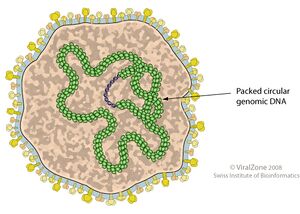Plasmavirus
Classification
Superkingdom: Viruses, Family: Plasmaviridae, Genus: Plasmavirus
Species
Plasmavirus L2
Description and Significance
Plasmavirus L2, part of the Plasmaviridae family, is a bacteria-infecting virus with only one known host, being Acholeplasma laidlawii. There is only one genus in the Plasmaviridae family, being Plasmavirus, and only one species Plasmavirus L2 (or Acholeplasma virus L2). Little is known about the Plasmaviridae family and because it is poorly studied the diversity and biology of these viruses is largely unknown.
The virion are enveloped, spherical to pleomorphic, with no head-tail structure ranging from diameters of 50-125 nm. The capsid is about 80 nm in diameter. The absence of a regular capsid structure suggests plasmavirus virions consist of a condensed nucleoprotein bounded by a proteinaceous lipid vesicle.
Genome Structure
Plasmavirus L2 is a virion that is part of a family of bacteriophages, having an envelope, nucleoprotein complex, and a capsid. They are between 50-125 nanometers in diameter, with an average of around 80 nm, and have a loose membrane surrounding them. They have a condensed, non-segmented genome that is a single molecule of circular, double-stranded, supercoiled DNA, being ~12000 bp in length. It has a dsDNA genome of about 12 kbp, encoding for at least 14 ORF (open reading frames).
The L2 genome that has been sequenced and analyzed is 11,965 bp long with 15 open reading frames that are clustered into four groups by noncoding intergenic regions, implying that the gene expression involves transcription of genes in a cluster into polycistronic mRNA (process where multiple separate proteins are being coded within one molecule) and translation of said genes via reinitiation or coupling.
Cell Structure, Metabolism and Life Cycle
Interesting features of cell structure; how it gains energy; what important molecules it produces.
Ecology and Pathogenesis
Plasmaviruses infect only one known species of Acholeplasma, which is a wall-less bacteria of the class Mollicutes, and release by budding through the cell membrane without causing host cell lysis. The viral genome is then integrated into the host chromosome and transcribed by host polymerase and a productive infectious cycle begins before a lysogenic cycle (process of integration into the host chromosome) begins within the infected bacteria. After the initial infection by the viral genome the virus may become dormant within the host. Although Acholeplasma laidlawii, a temperate bacteriophage, is the only current classified host of plasmavirus, related prophages reside in the genomes of different Acholeplasma species, where they are integrated into tRNA genes. Translational coupling or reinitiation may be involved in translation of the viral polycistronic mRNAs by the host translation machinery but not enough is known about the species to be sure.
References
[Sample reference] [http://ijs.sgmjournals.org/cgi/reprint/50/2/489 Takai, K., Sugai, A., Itoh, T., and Horikoshi, K. "Palaeococcus ferrophilus gen. nov., sp. nov., a barophilic, hyperthermophilic archaeon from a deep-sea hydrothermal vent chimney". International Journal of Systematic and Evolutionary Microbiology. 2000. Volume 50. p. 489-500.]
Author
Page authored by Nathaniel Asbell, student of Prof. Bradley Tolar at UNC Wilmington.
[[Category:Pages edited by students of Bradley Tolar at UNC Wilmington]]

